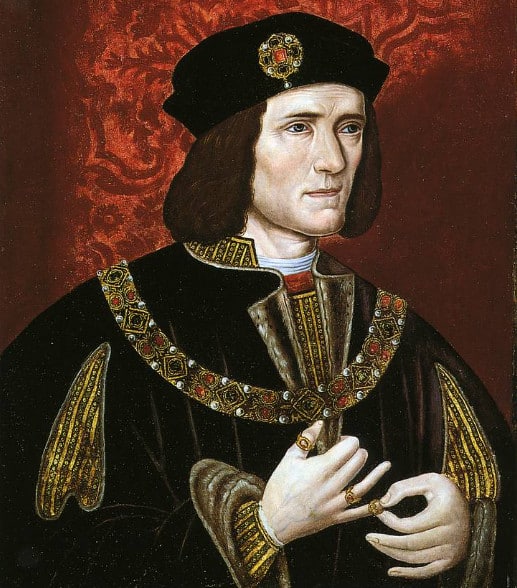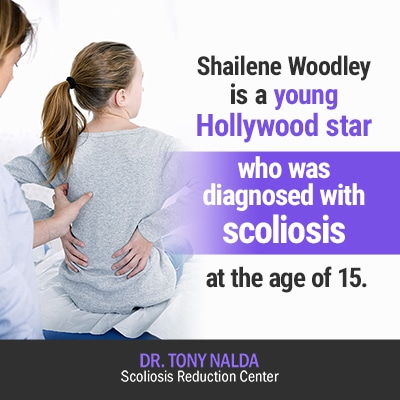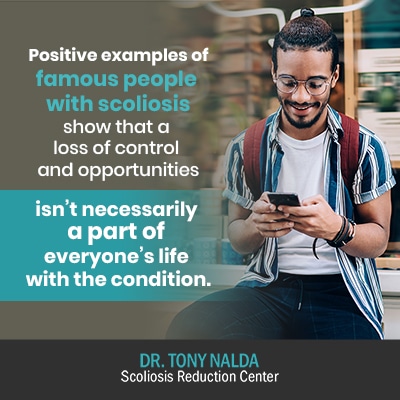I really enjoy talking about famous people with scoliosis because many are surprised to learn that celebrities they follow are living with the condition. These stories can be inspirational to people recently diagnosed, and especially to adolescents and teenagers who are struggling to process how having scoliosis will affect their lives.
There are many great examples of people who are not only living (or lived) life, with scoliosis, but are thriving with it:
- Lamar Gant
- Usain Bolt
- Sarah Michelle Gellar
- Elizabeth Taylor
- Maritza Correia
- King Richard III of England
- Rene Russo
- Shailene Woodley
Click on a celebrity above to learn more about their scoliosis story.
Scoliosis Prevalence and Incidence
With currently between seven and nine million people living with scoliosis in the United States alone, the condition is more prevalent than many realize, affecting 2-3 percent of the population.
Add to that the number of unknown cases, plus people with scoliosis from around the globe, and that number would increase exponentially.
While the condition is most commonly diagnosed in individuals between the ages of 10 and 18, it can develop at any age: infancy, early childhood, adolescence, or adulthood.
In addition, females are eight times more likely to experience curvature progression (meaning a curvature that gets larger); this is generally understood by experts as a result of earlier growth and development in females during the puberty stage.
With so many people living with scoliosis, there are bound to be famous people and celebrities amongst that group, and some might be people whose careers you’ve been following with no idea they have, or had, scoliosis.
Examples of people who are not only living their best lives with scoliosis, but who have managed to thrive despite of it, can be inspirational for people in need of hope and positivity. These examples of inspiration are particularly helpful for people who have just received a scoliosis diagnosis and are unsure of what kind of life they will be able to lead.
This is also a huge part of why I wrote Scoliosis Hope: to give people that hope, and to spread the message that a life with scoliosis doesn’t have to mean a life that is lacking.
Scoliosis Hope
When I wrote Scoliosis Hope, it was for two main reasons. I wanted people to be empowered with information regarding treatment options available to them, and I wanted patients and their families to see scoliosis in a new light: in a way that doesn’t have to define patients moving forward.
While I in no way believe that a scoliosis diagnosis is a small thing, or that it won’t pose additional challenges in life, what I do believe is that people with scoliosis can still be masters of their own bodies and lives.
I also know there is a huge psychological component to treatment success. The power of a positive mental attitude can go a long way in terms of how a patient responds to treatment and moves forward in life with their condition.
This is why I always enjoy the topic of famous people and celebrities with scoliosis because it shows what people can still accomplish, despite the challenges posed by their condition.
Many of these people are individuals that are followed, idolized, and respected, and when the general public sees they have achieved their level of success with a spinal condition, it can open peoples’ eyes to the possibilities of life with scoliosis.
One of the hardest things about giving someone a scoliosis diagnosis is to see those feelings of powerlessness sneaking in. Some people feel betrayed by their own bodies, as if they no longer have control over their bodies, lives, and goals they had set for their future.
I spend a lot of time addressing the psychological side of scoliosis in the book so people can see the benefits of having a positive mental attitude, and to share what it can feel like to be diagnosed with a progressive and incurable spinal condition; this helps parents and/or caregivers of someone recently diagnosed have a better understanding of what they are going through, making them better able to support their loved ones.
Here at the Scoliosis Reduction Center®, we work closely with our patients and their families to come up with a customized treatment plan for the whole patient, and that includes paying attention to the mental health of patients who are struggling.
I also find that one of the best safeguards of patients’ mental health is active treatment because the more involved a patient is in their condition, the more they are able to regain some of those feelings of lost control, especially as they start to see positive treatment results from their efforts.
Before we move on to discussing individual famous people and celebrities with scoliosis, let’s first touch on how active treatment can help patients both mentally and physically.
Treating Scoliosis
For those following our alternative functional scoliosis-treatment approach, active treatment is started as close to the time of diagnosis as possible.
We do this because we believe in making every effort possible to help patients avoid the hardships associated with the higher stages of scoliosis progression, but it also has another benefit: the patient’s mental health.
Generally, the most intense phase of treatment is during those first initial weeks, and this phase can involve a lot of hard work and dedication; fortunately, many of our patients see results after those first weeks of intense treatment.
With hard work, the early weeks of treatment can be very effective and motivating. When patients start to see their hard work paying off in the form of a curvature reduction and/or relief from related symptoms, they see how much power and control they still have over their bodies, and by extension, their lives.
The treatment regimen is adjusted accordingly, once we see how the spine is responding to treatment and growth (in cases of AIS).
The return of feelings of control and mastery over their own bodies is highly beneficial to patients in terms of their mental health.
Scoliosis Hope helps spread a more positive image of scoliosis. In it, I talk about the benefits of engaging in active treatment and how powerful a tool mental resilience can be when it comes to dealing with the rigors of treatment and living with a progressive spinal condition.
Hearing other peoples’ stories of how they faced the challenge of scoliosis and went on to live full lives adds hope to the condition’s narrative, potentially impacting how people look at life with scoliosis.
These stories can be particularly helpful for parents and/or caregivers of adolescents recently diagnosed, as many of these celebrities might be people they look up to and respect. From athletes to actors and musicians, there are countless examples of people who have still been able to thrive, despite having scoliosis.
While there are, obviously, extreme cases of scoliosis that can cause complications and limit a person’s ability to participate in certain activities, these are far less common than the many cases of people who, through active treatment, have figured out how to manage their condition and go on to live lives full of possibility.
Although the following celebrities were not treated here at the SRC, they do show that possibilities still exist for those who have received a scoliosis diagnosis. Let’s take a look at some of these stories of hope from famous people and celebrities who have lived, or are living, with scoliosis.
Lamar Gant
Lamar Gant is a powerful story of inspiration. Even after being diagnosed with scoliosis at the age of 14 during a routine football physical, he went on to hold the world’s deadlifting record in the 123- and 132-lb weight classes.
At the age of 17, Gant set his first world record when he deadlifted over 500 lbs. In 1980, he was inducted into the International Powerlifting Federation Hall of Fame. In 1985, Gant became the first person to successfully deadlift five times his body weight, and at the time, he only weighed 132 lbs, proving that having scoliosis doesn’t necessarily make a person weak.
Usain Bolt
Another of my favorite examples of someone living with and mastering their condition is Usian Bolt: the world’s fastest man.
Many have likely heard the name ‘Usain Bolt’ and know what he has accomplished, but might not realize he did so with scoliosis.
Bolt was born with congenital scoliosis, making his right leg .5” shorter than his left. There are a lot of uneven forces at work with scoliosis, and those forces can change the body’s symmetry and balance.
Despite the asymmetry of having one leg shorter than the other, Bolt was able to adjust his stride to not only to compensate for this, but to excel despite of it.
Sarah Michelle Geller
Embed from Getty Images
Sarah Michelle Geller, an American actress, best known for her role as Buffy in ‘Buffy the Vampire Slayer’ has had scoliosis since she was a child.
While she reports struggling with varying levels of back pain throughout her child and adult life, she was still able to accomplish her goal of becoming a successful actor, and uses exercise to help relieve the discomfort caused by her condition in a healthy and proactive way.
Elizabeth Taylor
Embed from Getty Images
Elizabeth Taylor is arguably one of the most famous actors known throughout the world. She was born with congenital scoliosis but didn’t let it slow her down or limit her accomplishments, including winning two oscars.
In addition to having scoliosis, Taylor faced numerous health challenges that led to her becoming an ultimate symbol of survival.
Maritza Correia
Embed from Getty Images
Olympic swimmer and world swimming-record holder, Maritza Correia was diagnosed with scoliosis when she was 7 years old.
Not only did Correia qualify for the United States olympic team in 2004, she also became a trailblazer as the first African-descended Puerto Rican to win a place on an American olympic team.
She was also the first black American swimmer to set an American and world-swimming record. Her scoliosis certainly didn’t slow her down or limit her life’s ambitions.
King Richard III of England

To cast our net farther back in history, let’s consider King Richard III, ruler or England from 1483 to 1485.
Richard III had been described by Shakespeare as a hunchback, but when the king’s bones were unearthed in 2012, archaeologists not only discovered an unnaturally-bent spine, but also a significantly twisted spine.
This ‘twist’ has come to be known as ‘rotation’ in the context of scoliosis, and a rotational component is one of the determining factors of whether an abnormal spinal curvature is true structural scoliosis, or an issue related to chronic bad posture.
From what the history books tell us, Richard III didn’t suffer mobility restrictions due to his condition. After carefully reconstructing the spine of Richard III, experts put his curvature at 70 or 80 degrees: in the ‘severe scoliosis’ range.
While paintings and images of the late king don’t include noticeable postural asymmetries, experts also agree that it’s likely a good tailor and custom-made armor could have helped conceal the physical symptoms of his severe scoliosis.
Rene Russo
Successful American actor, producer, and model, Rene Russo, was diagnosed with scoliosis when she was 10. Through bracing and various treatment efforts, she has been able to manage her condition and live her life successfully, while avoiding spinal-fusion surgery.
She has committed to an alternative treatment approach that focuses on integrating different treatment disciplines such as scoliosis-specific chiropractic and acupuncture.
Despite her condition, she has been able to thrive in the acting industry, becoming a shining example of what one can accomplish with scoliosis.
Shailene Woodley

Embed from Getty Images
Shailene Woodley is a young Hollywood star who was diagnosed with scoliosis at the age of 15. At that time, she had a 38-degree curvature, which is just under the severe- scoliosis designation of 40+ degrees.
She wore a back brace for 2 years to help control her condition’s progression. Not only is she leaving her mark on the film industry, she is also a great example for other young people with scoliosis because of her positive mental attitude.
Woodley is open about what living with scoliosis is like for her and frequently talks about how it has never kept her from being active or made playing a certain role more difficult.
In an interview, she even light-heartedly compared her scoliosis to someone else having to get braces for crooked teeth and describes her condition as having her initial on her spine.
She considers herself fortunate as she could have been diagnosed with a far more serious and/or debilitating condition.
Woodley’s attitude is an inspiration for other young people struggling to come to terms with their scoliosis diagnosis. She’s young, famous, successful, and doesn’t view her scoliosis as a negative force in her life.
Conclusion
Being diagnosed with an incurable progressive spinal condition is not an easy thing to face, but it doesn’t have to be a complete game-changer.
People with scoliosis can still live full and active lives. In fact, it’s even more important for people with scoliosis to remain active as part of managing their condition.
There are many misconceptions out there regarding scoliosis, but perhaps the most prevalent is that scoliosis means being weak and unable to participate in physical activity.
Misconceptions surrounding medical conditions can be dangerous, especially for those recently diagnosed. They can play into how a person responds to and views their condition, and this can affect their ability to maintain a positive attitude: an important component of mental health and treatment efficacy.

Patients with positive attitudes respond better to treatment. They are more hopeful and responsive, and this can greatly impact a patient’s ultimate prognosis. I find that positive examples of famous people and celebrities with scoliosis can go a long way in terms of rewriting the narrative surrounding scoliosis.
Looking at individual scoliosis stories of adversity, hope, and accomplishment are fantastic reference tools for those freshly diagnosed who might be doubting their ability to lead a normal life.
In the most common form of the condition, adolescent idiopathic scoliosis, we are talking about adolescents and teenagers; this age range can be particularly vulnerable to the effects a spinal condition can have on mental health as they are young and already entering into a stage marked by uncertainty.
With our patients, we can discuss the successes of people like Usain Bolt and Shailene Woodley, as examples of what people can accomplish, despite having scoliosis.
The stories of hope that famous people and celebrities with scoliosis provide have the power to shift the way the condition is looked at, and this can have huge benefits in terms of a patient’s perspective, mental health, and treatment efficacy.





